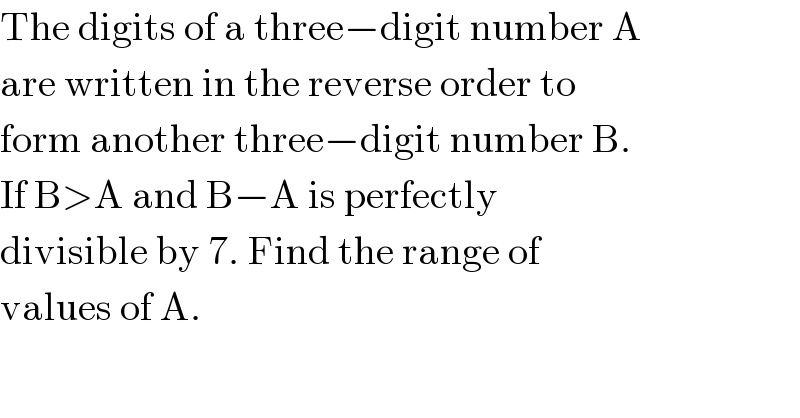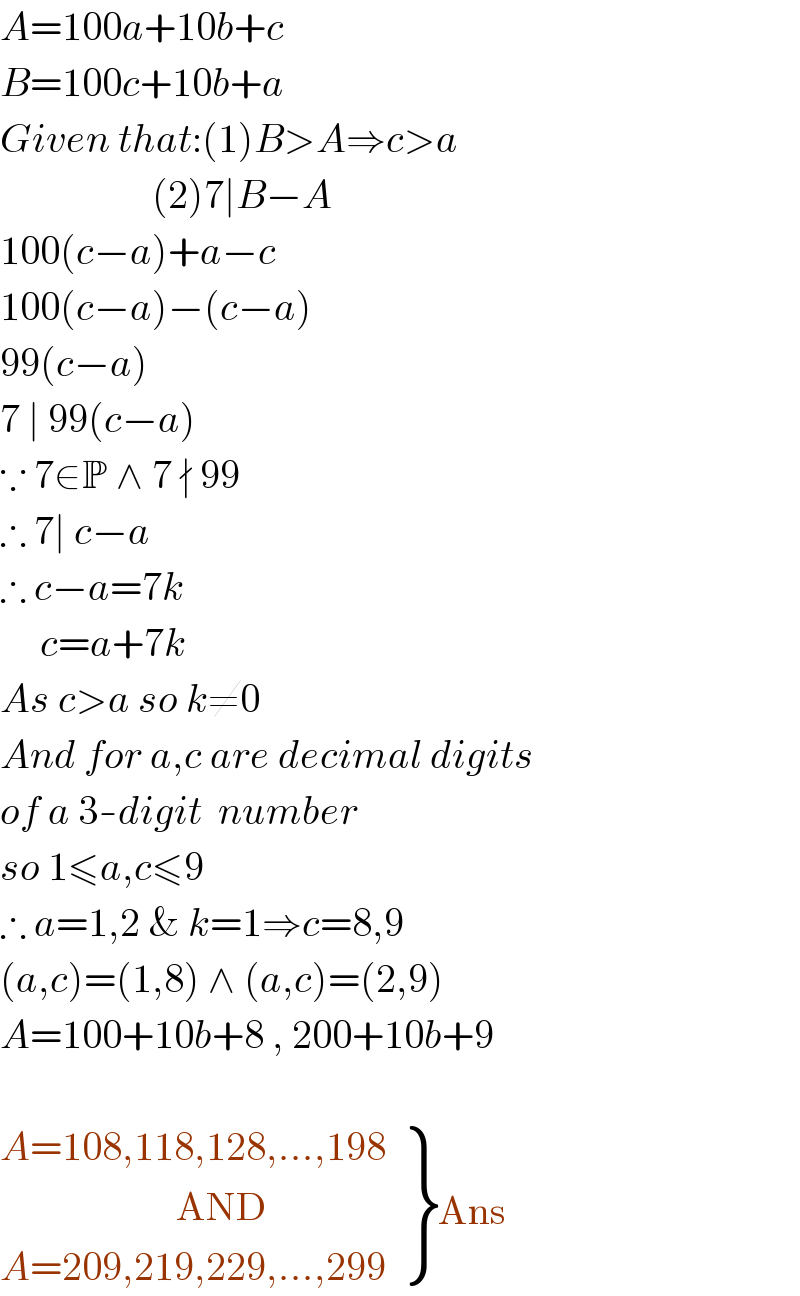
Question Number 113003 by Aina Samuel Temidayo last updated on 10/Sep/20

$$\mathrm{The}\:\mathrm{digits}\:\mathrm{of}\:\mathrm{a}\:\mathrm{three}−\mathrm{digit}\:\mathrm{number}\:\mathrm{A} \\ $$ $$\mathrm{are}\:\mathrm{written}\:\mathrm{in}\:\mathrm{the}\:\mathrm{reverse}\:\mathrm{order}\:\mathrm{to} \\ $$ $$\mathrm{form}\:\mathrm{another}\:\mathrm{three}−\mathrm{digit}\:\mathrm{number}\:\mathrm{B}. \\ $$ $$\mathrm{If}\:\mathrm{B}>\mathrm{A}\:\mathrm{and}\:\mathrm{B}−\mathrm{A}\:\mathrm{is}\:\mathrm{perfectly} \\ $$ $$\mathrm{divisible}\:\mathrm{by}\:\mathrm{7}.\:\mathrm{Find}\:\mathrm{the}\:\mathrm{range}\:\mathrm{of} \\ $$ $$\mathrm{values}\:\mathrm{of}\:\mathrm{A}. \\ $$
Commented byRasheed.Sindhi last updated on 10/Sep/20

$$\overset{?} {{miss}}/\overset{?} {{mr}}\:{Aina}\:{pl}\:{read}\:{my}\:{comment} \\ $$ $$\left({Is}\:{the}\:{answer}\:\mathrm{8}?\right)\:{of}\:{Q}#\mathrm{112810} \\ $$
Commented byAina Samuel Temidayo last updated on 10/Sep/20

$$\mathrm{Replied}\checkmark \\ $$
Answered by Rasheed.Sindhi last updated on 14/Sep/20

$${A}=\mathrm{100}{a}+\mathrm{10}{b}+{c} \\ $$ $${B}=\mathrm{100}{c}+\mathrm{10}{b}+{a} \\ $$ $${Given}\:{that}:\left(\mathrm{1}\right){B}>{A}\Rightarrow{c}>{a} \\ $$ $$\:\:\:\:\:\:\:\:\:\:\:\:\:\:\:\:\:\:\:\left(\mathrm{2}\right)\mathrm{7}\mid{B}−{A} \\ $$ $$\mathrm{100}\left({c}−{a}\right)+{a}−{c} \\ $$ $$\mathrm{100}\left({c}−{a}\right)−\left({c}−{a}\right) \\ $$ $$\mathrm{99}\left({c}−{a}\right) \\ $$ $$\mathrm{7}\:\mid\:\mathrm{99}\left({c}−{a}\right) \\ $$ $$\because\:\mathrm{7}\in\mathbb{P}\:\wedge\:\mathrm{7}\:\nmid\:\mathrm{99} \\ $$ $$\therefore\:\mathrm{7}\mid\:{c}−{a} \\ $$ $$\therefore\:{c}−{a}=\mathrm{7}{k} \\ $$ $$\:\:\:\:\:{c}={a}+\mathrm{7}{k} \\ $$ $${As}\:{c}>{a}\:{so}\:{k}\neq\mathrm{0} \\ $$ $${And}\:{for}\:{a},{c}\:{are}\:{decimal}\:{digits} \\ $$ $${of}\:{a}\:\mathrm{3}-{digit}\:\:{number} \\ $$ $${so}\:\mathrm{1}\leqslant{a},{c}\leqslant\mathrm{9} \\ $$ $$\therefore\:{a}=\mathrm{1},\mathrm{2}\:\&\:{k}=\mathrm{1}\Rightarrow{c}=\mathrm{8},\mathrm{9} \\ $$ $$\left({a},{c}\right)=\left(\mathrm{1},\mathrm{8}\right)\:\wedge\:\left({a},{c}\right)=\left(\mathrm{2},\mathrm{9}\right) \\ $$ $${A}=\mathrm{100}+\mathrm{10}{b}+\mathrm{8}\:,\:\mathrm{200}+\mathrm{10}{b}+\mathrm{9} \\ $$ $$ \\ $$ $$\left.\begin{matrix}{{A}=\mathrm{108},\mathrm{118},\mathrm{128},...,\mathrm{198}}\\{\:\:\:\:\:\:\:\:\:\:\:\:\:\:\:\:\:\:\:\:\:\:\mathrm{AND}}\\{{A}=\mathrm{209},\mathrm{219},\mathrm{229},...,\mathrm{299}}\end{matrix}\right\}\mathrm{Ans} \\ $$
Commented byAina Samuel Temidayo last updated on 11/Sep/20

$$\mathrm{Thanks}. \\ $$
Commented byRasheed.Sindhi last updated on 12/Sep/20

$$\mathcal{T}{he}\:{last}\:{part}\:{of}\:{my}\:{answer}\:{is}\: \\ $$ $${erroneous}.\:{I}'{ll}\:{correct}\:{it}. \\ $$
Commented byRasheed.Sindhi last updated on 14/Sep/20

$${Corrected}. \\ $$
